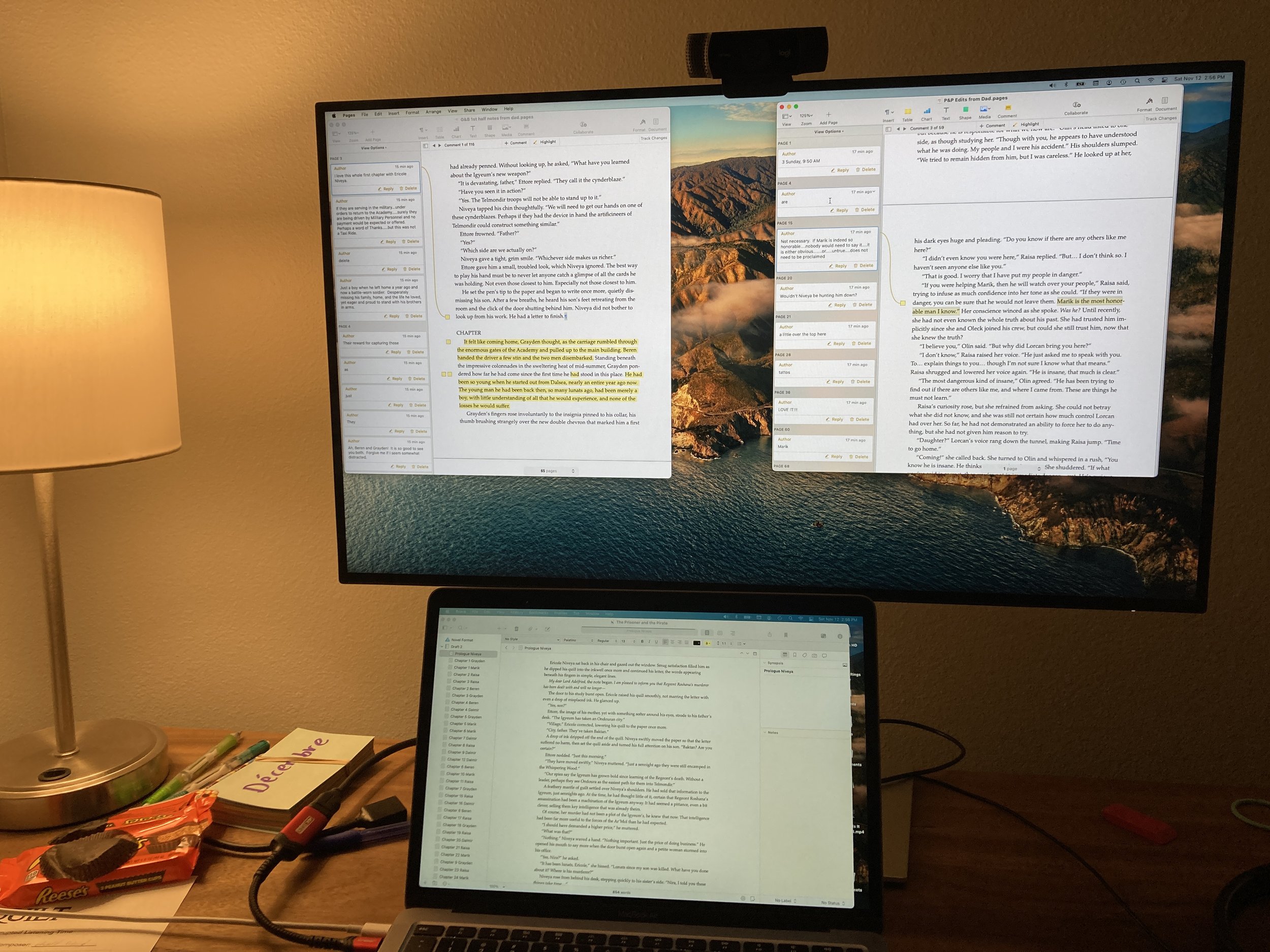Step Behind the Writer's Desk
Good morning, Fearless Adventurers!
As I’ve been writing up a storm here in the Stormcave for the past month and a half, I thought maybe you would enjoy a bit more of a peek into my process. From first idea to published product… what goes on behind the page, as it were?
First, there’s an idea.
Just a little glimmer of one sometimes. Or maybe a full-fledged story newly hatched and fluttering about with tiny wings much too frail to lift even the barest wisp of breath above the ground.
Sometimes it’s a character. Sometimes it’s a plot thread. Sometimes it’s just an image. But there is always a spark of an idea hidden there.
Then there’s a flurry of world-building. I used to let the world develop as I wrote… but it tends to require so much editing and revising after the fact that now I try to do a lot more of it up front.
Side note: I think this is the number one reason that speculative-fiction authors write series more than other kinds of authors. The world building is such a huge aspect of the writing, and if you can stay in the same world that you had in the previous book, that makes everything easier!
Once the world is sufficiently fleshed out, I will generally sit down and work out an outline. This might happen concurrently with the world-building, as well. I used to write like Han Solo flying through an asteroid field, but I have gradually and slowly begun to learn the value of outlines. (A value that my English teachers never could get me to admit to back in school…. I was definitely that kid who wrote whole papers weeks before they were due so that I could know what would be in my outline which was inevitably due before the paper). This process takes a day to a week, depending on the story.
Then there is the drafting. This can take anywhere from a 2-4 months, depending on the length of the story. I feel like I’ve gotten quite a lot faster than I used to be. Or more diligent. Or… something.
When I’ve finished this step, I send the rough draft to my developmental editor
Yep.
You read that right. I send my rough draft to another person…. and I let them read it!
le gasp
Jenelle of yesteryear would never have dreamed of doing something so incredibly rash or scary. To show somebody my unedited scribblings? To let them see just how horribly my story is at the very beginning?
I get it. That sounds insane.
But here’s the deal. I have worked with this editor for 20 years. This is a level of trust that has developed over many many many drafts and hours of work. And about two years ago, I realized that doing it this way saves me a ton of time.
I can write my rough draft, and then spend 400 hours editing and polishing the story before I send it to my editor. But then, no matter how much time and effort I put into the self-editing, he invariably sends me about 400 hours of work that I still have to do.
But…. if I send him my rough draft… he might only send me about 500 hours of work to do.
That’s a 75% savings in time for me.
That’s a no-brainer.
Oh, and the header image for this post? That’s my actual view at my desk right now as I am going over my developmental editor’s notes for The Prisoner and the Pirate, trying to weave the new subplot into the existing story while making all the editing changes at the same time!
Yes… it’s more than a little overwhelming. But we’ll tackle it like any great journey worth taking… one step at a time. One line at a time.
Send Halp!
Next it’s time for line-editing
I do this in two stages. First, I send it through ProWriting Aid and do a lot of smoothing and fixing on my own.
Here is where I add a large disclaimer:
While I find ProWriting Aid to be a very useful tool, I only recommend it on the caveat that you have enough confidence in your own writing to say, “No. I am not going to change that.” The reason being, that PWA (and other AI editors) may have a good grasp on grammar and spelling (but they aren’t always right!) they will not preserve your voice or style. If you make every change they recommend, you might end up with a technically perfect story, but you run the very real risk of allowing the AI to pull all your heart and soul out of the story… resulting in something that sounds like a computer wrote it.
So I use this tool to catch what typos/grammar it can, some overused words that I tend to struggle with always, and a few other tools that I use very sparingly.
Then I send the story to my line-editor, who adds an extra layer of polish. She finds my overused words (or the places where I’ve used the same word/wording/phrase too close together), lets me know when my world-building is hard to follow, keeps tabs on when and how I introduce various characters, and points out typos along the way, as well.
Then it’s off to the proofreader
This is where all the typos and inconsistencies and punctuation gets ironed out. But my proof-reader is extra specially epic and wonderful because she also makes sure to catch things like, “Hey, this character’s eye color changed” or “um, your character is 12 years old, says he’ll be gone for 4 years, and is now saying he’ll be 18 when he gets back… might want to check your math.” And things like that. Love it.
Honestly, this is one of the most fun sets of notes to get back because it means the story is nearly complete. Once I’ve made the necessary changes (so long as there weren’t any major changes required, which might necessitate sending that scene back to my proof-reader to make sure I didn’t add any errors in while taking her suggestion… yes… this happens!) then the book is ready for formatting!!!
Along the way, I generally start working with my cover artist
This can take anywhere from 1-6 months depending on how full my artist’s calendar is or how intensive the cover art is or how picky I’m being. (I’m picky, y’all).
So I like to be doing this at the same time as some of those other steps if I can. Usually I don’t start until after the rough draft is written.
Once the book is edited, polished, proofed, formatted, and has a cover….
It’s ready to be released back into the wild.
And that’s my process.
From start to finish… this process has taken me as long as 10 years and as short a time as 1 year. So I have high hopes that once I start publishing Turrim Archive, I can start working on some of those other smaller projects on my list of “to be written” and keep the momentum going. It probably won’t continue to be a book every three months, but hopefully there won’t be many more 3-year gaps between publications!
If you are an author, how does your process look from start to finish?
Did you enjoy this peek into my writing/publishing process? Would you like more posts in this vein?





